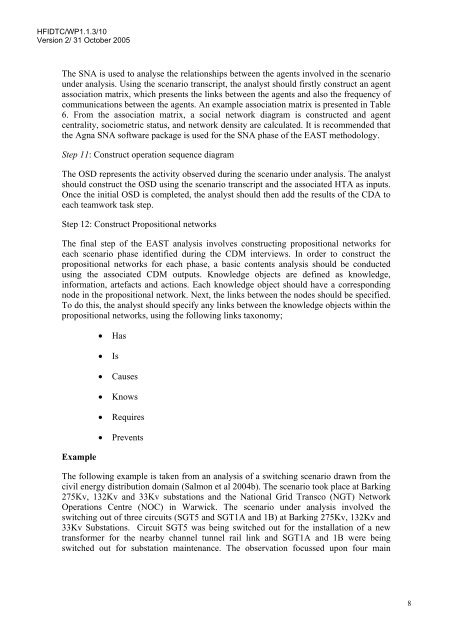A Review of the Event Analysis of Systemic Teamwork Methodology
A Review of the Event Analysis of Systemic Teamwork Methodology
A Review of the Event Analysis of Systemic Teamwork Methodology
- No tags were found...
Create successful ePaper yourself
Turn your PDF publications into a flip-book with our unique Google optimized e-Paper software.
HFIDTC/WP1.1.3/10<br />
Version 2/ 31 October 2005<br />
The SNA is used to analyse <strong>the</strong> relationships between <strong>the</strong> agents involved in <strong>the</strong> scenario<br />
under analysis. Using <strong>the</strong> scenario transcript, <strong>the</strong> analyst should firstly construct an agent<br />
association matrix, which presents <strong>the</strong> links between <strong>the</strong> agents and also <strong>the</strong> frequency <strong>of</strong><br />
communications between <strong>the</strong> agents. An example association matrix is presented in Table<br />
6. From <strong>the</strong> association matrix, a social network diagram is constructed and agent<br />
centrality, sociometric status, and network density are calculated. It is recommended that<br />
<strong>the</strong> Agna SNA s<strong>of</strong>tware package is used for <strong>the</strong> SNA phase <strong>of</strong> <strong>the</strong> EAST methodology.<br />
Step 11: Construct operation sequence diagram<br />
The OSD represents <strong>the</strong> activity observed during <strong>the</strong> scenario under analysis. The analyst<br />
should construct <strong>the</strong> OSD using <strong>the</strong> scenario transcript and <strong>the</strong> associated HTA as inputs.<br />
Once <strong>the</strong> initial OSD is completed, <strong>the</strong> analyst should <strong>the</strong>n add <strong>the</strong> results <strong>of</strong> <strong>the</strong> CDA to<br />
each teamwork task step.<br />
Step 12: Construct Propositional networks<br />
The final step <strong>of</strong> <strong>the</strong> EAST analysis involves constructing propositional networks for<br />
each scenario phase identified during <strong>the</strong> CDM interviews. In order to construct <strong>the</strong><br />
propositional networks for each phase, a basic contents analysis should be conducted<br />
using <strong>the</strong> associated CDM outputs. Knowledge objects are defined as knowledge,<br />
information, artefacts and actions. Each knowledge object should have a corresponding<br />
node in <strong>the</strong> propositional network. Next, <strong>the</strong> links between <strong>the</strong> nodes should be specified.<br />
To do this, <strong>the</strong> analyst should specify any links between <strong>the</strong> knowledge objects within <strong>the</strong><br />
propositional networks, using <strong>the</strong> following links taxonomy;<br />
Example<br />
• Has<br />
• Is<br />
• Causes<br />
• Knows<br />
• Requires<br />
• Prevents<br />
The following example is taken from an analysis <strong>of</strong> a switching scenario drawn from <strong>the</strong><br />
civil energy distribution domain (Salmon et al 2004b). The scenario took place at Barking<br />
275Kv, 132Kv and 33Kv substations and <strong>the</strong> National Grid Transco (NGT) Network<br />
Operations Centre (NOC) in Warwick. The scenario under analysis involved <strong>the</strong><br />
switching out <strong>of</strong> three circuits (SGT5 and SGT1A and 1B) at Barking 275Kv, 132Kv and<br />
33Kv Substations. Circuit SGT5 was being switched out for <strong>the</strong> installation <strong>of</strong> a new<br />
transformer for <strong>the</strong> nearby channel tunnel rail link and SGT1A and 1B were being<br />
switched out for substation maintenance. The observation focussed upon four main<br />
8
















